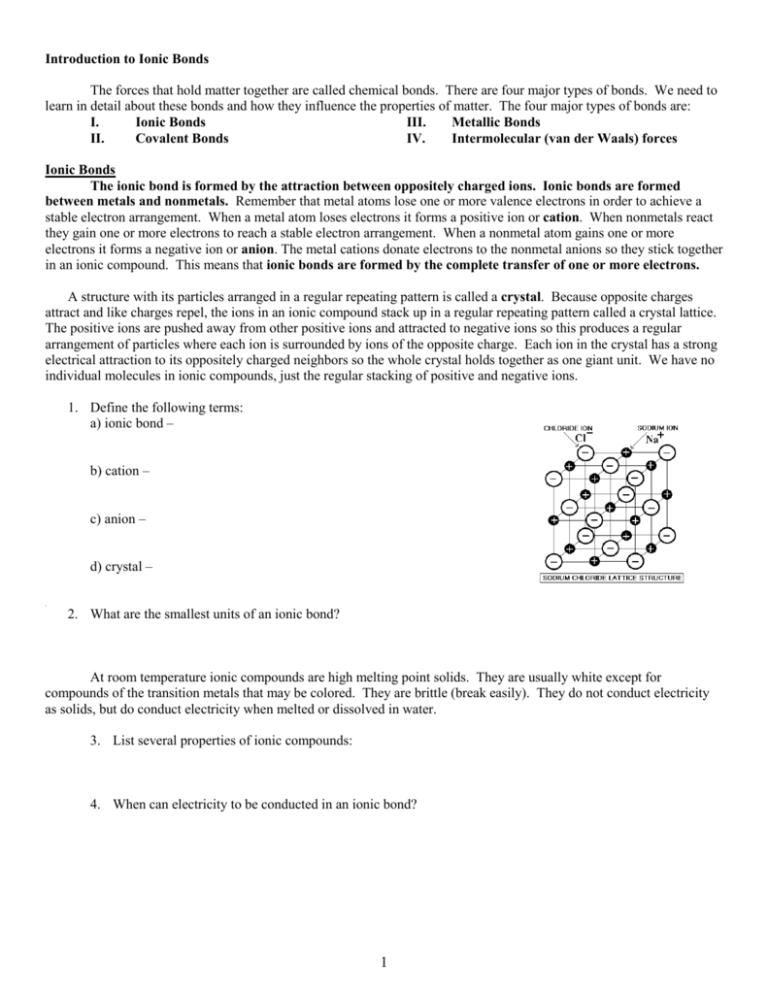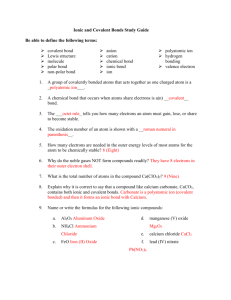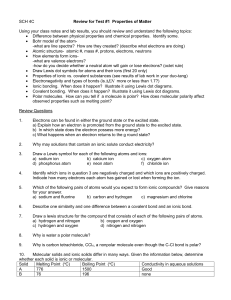Introduction to Ionic Bonds The forces that hold matter together are
advertisement

Introduction to Ionic Bonds The forces that hold matter together are called chemical bonds. There are four major types of bonds. We need to learn in detail about these bonds and how they influence the properties of matter. The four major types of bonds are: I. Ionic Bonds III. Metallic Bonds II. Covalent Bonds IV. Intermolecular (van der Waals) forces Ionic Bonds The ionic bond is formed by the attraction between oppositely charged ions. Ionic bonds are formed between metals and nonmetals. Remember that metal atoms lose one or more valence electrons in order to achieve a stable electron arrangement. When a metal atom loses electrons it forms a positive ion or cation. When nonmetals react they gain one or more electrons to reach a stable electron arrangement. When a nonmetal atom gains one or more electrons it forms a negative ion or anion. The metal cations donate electrons to the nonmetal anions so they stick together in an ionic compound. This means that ionic bonds are formed by the complete transfer of one or more electrons. A structure with its particles arranged in a regular repeating pattern is called a crystal. Because opposite charges attract and like charges repel, the ions in an ionic compound stack up in a regular repeating pattern called a crystal lattice. The positive ions are pushed away from other positive ions and attracted to negative ions so this produces a regular arrangement of particles where each ion is surrounded by ions of the opposite charge. Each ion in the crystal has a strong electrical attraction to its oppositely charged neighbors so the whole crystal holds together as one giant unit. We have no individual molecules in ionic compounds, just the regular stacking of positive and negative ions. 1. Define the following terms: a) ionic bond – b) cation – c) anion – d) crystal – 2. What are the smallest units of an ionic bond? At room temperature ionic compounds are high melting point solids. They are usually white except for compounds of the transition metals that may be colored. They are brittle (break easily). They do not conduct electricity as solids, but do conduct electricity when melted or dissolved in water. 3. List several properties of ionic compounds: 4. When can electricity to be conducted in an ionic bond? 1 Reviewing Lewis Dot Diagrams Write the Lewis Dot Diagrams for the following: helium atom: beryllium atom: beryllium ion: neon atom: aluminum atom: aluminum ion: magnesium atom: magnesium ion: sodium atom: sodium ion: Write the Lewis Dot Diagrams for: oxygen atom: oxide ion: chlorine atom: chloride ion: phosphorus atom: phosphide ion: How would you describe (in general) the Lewis Dot Diagram for: a) a cation? b) an anion? What type of bonding would you expect in a compound that contains a metal and a nonmetal? 2 Drawing Ionic Bonds Remember: Ionic bonds form between POSITIVE IONS and NEGATIVE IONS. Ionic bonding is when one of the atoms is donating an electron(s) (the cation) and one of atoms is accepting an electron(s) (the anion). The electrons are not shared, the anion gains an electron(s) to achieve a full valence and the cation loses an electron(s) to achieve a full valence. Diagram the ionic bonding process from neutral atoms to ions showing the valence electrons and indicating with arrows the direction in which the electrons are going. Write your final answer in the box. Ex: sodium nitride (Na3N) 1. sodium chloride (NaCl) 5. potassium fluoride (KF) 2. barium oxide (BaO) 6. sodium oxide (Na2O) 3. magnesium chloride (MgCl2) 7. aluminum chloride (AlCl3) 4. calcium chloride (CaCl2) 8. rubidium oxide (Rb2O) 3 Introduction to Covalent Bonds A covalent bond is formed between nonmetal atoms. The nonmetals are connected by a shared pair of valence electrons. Remember, nonmetals want to gain valence electrons to reach a stable arrangement. If there are no metal atoms around to give them electrons, nonmetal atoms share their valence electrons with other nonmetal atoms. Since the two atoms are using the same electrons they are stuck to each other in a neutral particle called a molecule. A molecule is a neutral particle of two or more atoms bonded to each other. Molecules may contain atoms of the same element such as N2, O2, and Cl2 or they may contain atoms of different elements like H2O, NH3, or C6H12O6. Therefore, covalent bonding is found in nonmetallic elements and in nonmetallic compounds. Covalent bonds are intramolecular forces; that is, they are inside the molecule and hold the atoms together to make the molecule. Covalent bonds are strong bonds and it is difficult and requires a lot of energy to break a molecule apart into its atoms. However, since molecules are neutral one molecule does not have a strong electrical attraction for another molecule. The attractions between molecules are called intermolecular forces and these are weak forces. Covalent substances have low melting points and boiling points compared to ionic compounds or metals. At room temperature, covalent substances are gases, liquids or low melting point solids. They do not conduct electricity as solids or when molten and usually do not conduct when dissolved in water. 1. Define the following terms: a) covalent bond – b) molecule – c) intramolecular force– d) intermolecular force– 2. List several properties of covalent compounds. There are many types of covalent bonds. A single covalent bond is when two atoms share one pair of valence electrons (see figure). A double covalent bond is when two atoms share two pairs of valence electrons. A triple covalent bond is when two atoms share three pairs of valence electrons. 3. Define the following terms: a) single covalent – b) double covalent – c) triple covalent – 4 5 6 7 Polarity When atoms share valence electrons they do not always share them equally. Frequently one atom has a stronger attraction for the electrons than the other atom does. This uneven attraction causes the electrons to be held closer to one end of the bond than the other; we say this makes one end of the bond slightly positive and the other end of the bond slightly negative. A covalent bond with uneven sharing of the electrons is called a polar covalent bond. A bond in which the electrons are shared equally is called a nonpolar covalent bond. 1. Define the following terms: a. polar covalent b. nonpolar covalent 2. Label the following compounds as nonpolar, polar or ionic: a. NH3 e.H2O b. MgO f. NaCl c. Cl2 g. CH4 d. HCl h. NO2 8 Metallic Bonds A metallic bond forms between multiple metal atoms. The metallic bond is formed by the mutual attraction for each others loosely held valence electrons. Most metal atoms have only one or two valence electrons and these are not tightly bound to the atoms. In a piece of metal these valence electrons do not seem to belong to any one of the atoms but are able to move freely through the structure from one atom to another. Metals can be thought of as positive ions (the nucleus and inner shells of electrons—all of the atom except the valence electrons) in a “sea” of loose valence electrons. The metal ions line up in a regular repeating pattern (a crystal lattice) and their loose valence electrons move through this crystal acting as an electron glue (see figure). Each of the ions is strongly attracted to all of the loose electrons surrounding it so the whole metal holds together as a crystal. These electrical attractions for the electron glue are strong and hard to break so metals are high melting point crystalline solids. Since there are charged particles free to move metals are good conductors of heat and electricity as solids and as liquids. Because the “electron glue” is free to move, if we hammer or pull the cations to new positions the electron glue flows right along with the cations and holds the structure together in the new position. Thus, metals are malleable (bendable) and ductile (can be hammered flat) and have a high tensile strength (can be stretched without breaking). This loose cloud of electrons is good at absorbing and re-emitting the light energy that strikes it so metals are lustrous (shiny). Metallic bonding is found in elemental metals and in mixtures of metals called alloys. 1. What is a metallic bond? Explain how the ions and electrons are arranged. 2. List some properties of metallic bonds. 3. What is an alloy? 4. Identify the following compounds as metallic, ionic or covalent: a. NaCl e. Mg3N2 b. Cl2 f. c. Au g. Al d. [BrO3]-1 Pt h. Ag 9 Bonding Pictures Review Sheet Draw Lewis dot diagrams for the following compounds. Remember that you must check the difference in electronegativity—to identify the compound as polar or nonpolar. a) water (H2O) b) potassium iodide (KI) c) nitrogen molecule (N2) d) ammonia (NH3) e) calcium iodide (CaI2) f) phosphorous trichloride (PI3) g) aluminum fluoride (AlF3) h) carbon dioxide (CO2) i) oxygen molecule (O2) j) magnesium nitride (Mg3N2) 10 k) chlorine molecule (Cl2) l) ethane (C2H6) (carbons hook to each other with H’s all around) m) hydroxide ion [OH]-1 n) sulfite ion [SO2]-2 o) ammonium ion [NH4]+1 p) sodium oxide (Na2O) q) sulfate ion [SO4]-2 r) calcium bromide (CaBr2) s) methane (CH4) t) sulfur dioxide (SO2) 11







